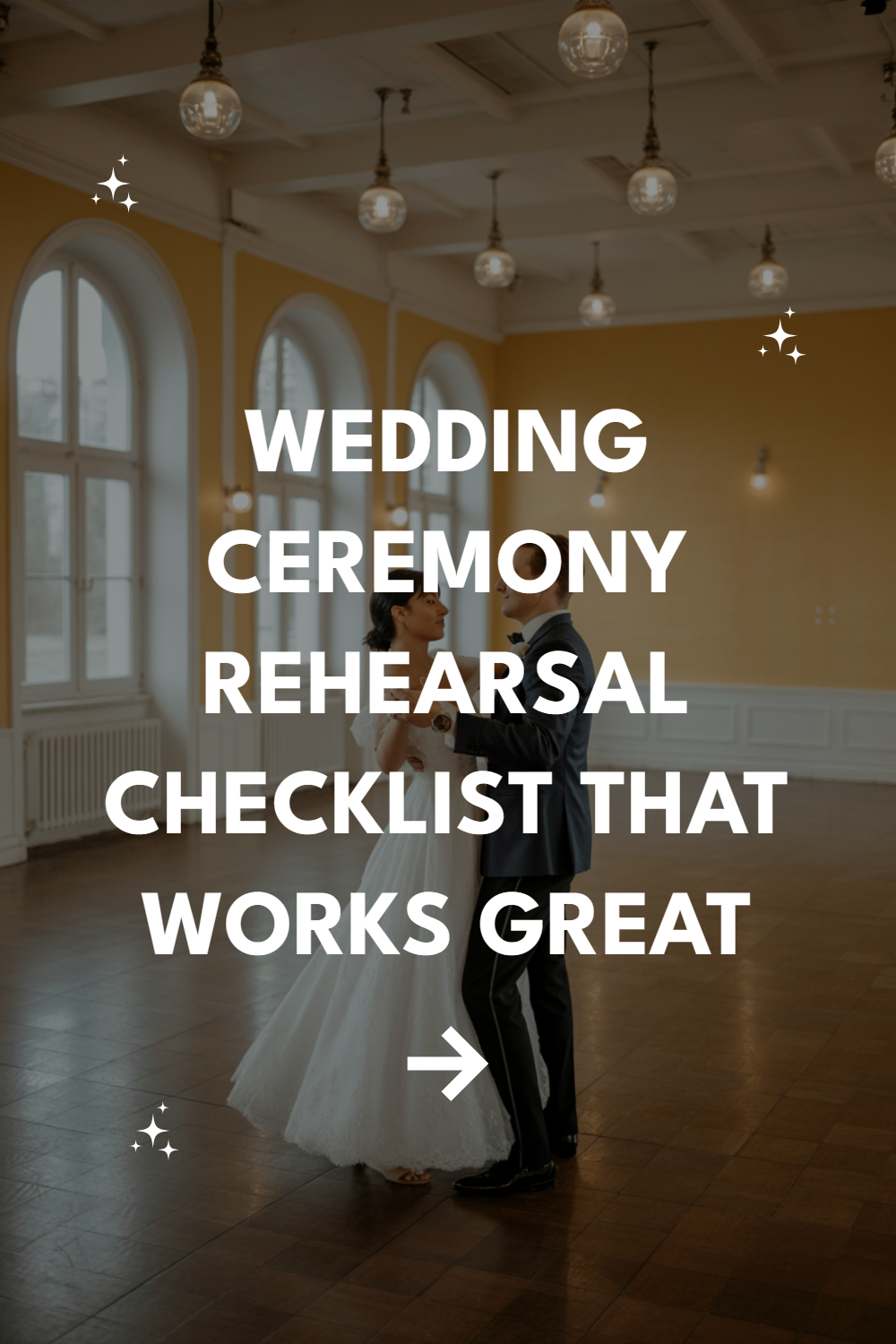Your wedding rehearsal isn’t just a formality—it’s your safety net.
After watching countless couples stumble through their big day because they skipped this crucial step, I can tell you that a well-run rehearsal is the difference between graceful confidence and awkward chaos.
Pre-Rehearsal Planning Essentials
Scheduling the Perfect Time
Most couples default to the night before their wedding, but that’s not always your best bet. If you’re having a destination wedding or expecting out-of-town guests to participate, consider scheduling your rehearsal two days before the ceremony.
Thursday evening rehearsals give everyone Friday to recover, especially if you’re planning a rehearsal dinner with an open bar. Your officiant and venue coordinator will also appreciate not being rushed on wedding eve.
Gathering Your Essential Players
Your rehearsal guest list should be lean but complete. Include anyone who has a specific role during the ceremony—not just people you love.
The must-haves are your wedding party, parents, officiant, and anyone doing readings or special performances. Ring bearers and flower girls under eight can skip it (they’ll wing it beautifully anyway), but their parents should attend to understand the timing.
Venue Coordination and Setup
Confirming Space Availability
Double-check that your ceremony space will actually be available for rehearsal. Churches often have evening services, and outdoor venues might have lighting limitations.
If your ceremony location isn’t available, find a similar space or even use your reception venue’s lobby. The goal is practicing the movements and timing, not perfecting the exact footwork.
Essential Items to Bring
Create a rehearsal kit that includes copies of your ceremony script, a list of participants’ names (trust me, your officiant will forget), and any props you’ll use. Bring a speaker for processional music—walking in silence feels awkward and throws off your timing.
Pack comfortable shoes for everyone, especially if you’re rehearsing outdoors. Twisted ankles the night before your wedding aren’t cute.
Processional and Positioning Practice
Mastering the Walk
Your processional speed should feel unnaturally slow. Most couples rush down the aisle like they’re late for a train.
Practice walking to the beat of your chosen music, taking one step per beat. Bridesmaids should space themselves about six pews apart—close enough to look cohesive, far enough to avoid stepping on trains.
Positioning at the Altar
Work out where everyone stands before you start walking. Your officiant should mark spots with tape or have people practice their positions multiple times.
Tall groomsmen go in the middle, shorter ones on the ends—this creates better photos and sightlines. Bridesmaids should angle slightly toward the couple, not stand in a straight line like they’re waiting for a bus.
Ceremony Flow and Timing
Script Run-Through Essentials
Read through your entire ceremony script, including any special rituals or cultural traditions. This isn’t the time to be shy—speak up so everyone can hear their cues.
Practice any complicated elements like unity ceremonies, handfasting, or family traditions. These moments often involve multiple people and props, making them prime opportunities for confusion.
Managing Special Elements
| Element | Rehearsal Focus | Common Issues |
|---|---|---|
| Ring Exchange | Practice hand positions | Shaky hands, wrong fingers |
| Unity Candle | Test lighter/matches | Wind, timing with music |
| Sand Ceremony | Pour slowly | Overfilling, uneven layers |
| Cultural Rituals | Explain significance | Timing, participant confusion |
Music and Cue Coordination
Your musicians or DJ should attend the rehearsal, or at least send a representative who understands your timeline. Practice starting and stopping music on cue.
Designate someone to give musical cues—usually your wedding coordinator or a reliable family member. Hand signals work better than whispered instructions.
Recessional and Exit Strategy
Perfecting Your Grand Exit
Your recessional should be faster than your processional, but not a sprint. Practice pausing for a kiss after being pronounced married—this gives photographers great shots and lets the moment sink in.
The wedding party should recess in reverse order, with the couple leading. Parents and special guests can follow, or exit through side doors if your venue allows.
Guest Flow Management
Brief your ushers on post-ceremony guest management. Should people wait for photos? Head directly to cocktails? Knowing the plan prevents that awkward milling-around period.
If you’re taking family photos immediately after the ceremony, designate someone to wrangle relatives. Aunt Martha will wander off if no one’s watching.
Troubleshooting Common Issues
Weather Contingency Plans
Outdoor ceremonies need solid backup plans, and your rehearsal should include a quick run-through of Plan B. Even if the forecast looks perfect, show everyone where you’ll move if weather hits.
Practice the indoor setup if possible, or at least walk through the revised timeline. Indoor ceremonies often require different processional routes and positioning.
Managing Nervous Participants
Some people freeze up during rehearsals, especially those doing readings or performing music. Create a supportive atmosphere by keeping things light and reassuring everyone that mistakes are normal.
For extremely nervous readers, consider having them practice their piece twice during rehearsal. Familiarity breeds confidence.
Handling Difficult Personalities
Every wedding has that one person who thinks they know better than your officiant. Politely but firmly redirect their “suggestions” and keep the rehearsal moving.
If someone’s being disruptive, have your wedding coordinator or a trusted family member handle them privately. Don’t let one person derail everyone else’s preparation.
Final Details and Coordination
Rehearsal Dinner Transition
Plan the logistics of getting from rehearsal to dinner, especially if venues are far apart. Designate drivers for elderly relatives or those unfamiliar with the area.
Brief your wedding party on timing expectations for the next day. Now’s the time to share hotel information, transportation details, and morning schedules.
Day-Of Reminders
| Task | Responsible Person | Timing |
|---|---|---|
| Venue unlock | Coordinator/Venue | 2 hours before |
| Sound system check | DJ/Musician | 90 minutes before |
| Flower delivery | Florist/Coordinator | 1 hour before |
| Guest seating setup | Ushers | 30 minutes before |
Emergency Contact Information
Share key phone numbers with your wedding party and immediate family. Include your coordinator, venue manager, photographer, and any vendors who’ll be present on wedding day.
Create a group text with essential people so last-minute updates reach everyone simultaneously.
Making It Memorable
Your rehearsal sets the tone for your wedding day, so keep it relaxed but focused. A good rehearsal leaves everyone feeling confident and excited rather than stressed and confused.
Don’t aim for perfection—aim for preparedness. Small mistakes during the rehearsal are actually good luck, and they help identify potential issues before they matter.
Your wedding ceremony should feel natural and joyful, and a thorough rehearsal makes that possible.


